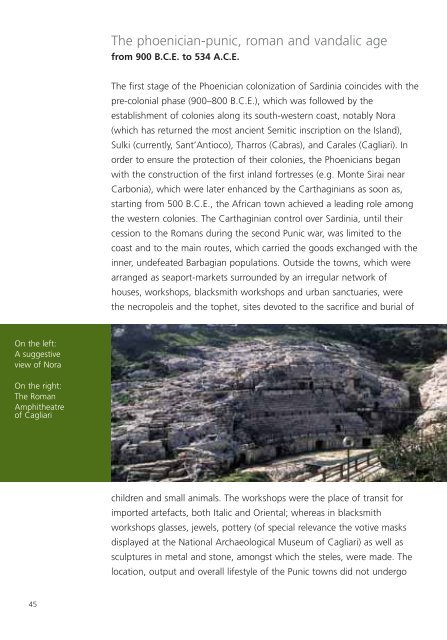Create successful ePaper yourself
Turn your PDF publications into a flip-book with our unique Google optimized e-Paper software.
The phoenician-punic, roman and vandalic age<br />
from 900 B.C.E. to 534 A.C.E.<br />
The first stage of the Phoenician colonization of Sardinia coincides with the<br />
pre-colonial phase (900–800 B.C.E.), which was followed by the<br />
establishment of colonies along its south-western coast, notably Nora<br />
(which has returned the most ancient Semitic inscription on the Island),<br />
Sulki (currently, Sant’Antioco), Tharros (Cabras), and Carales (Cagliari). In<br />
order to ensure the protection of their colonies, the Phoenicians began<br />
with the construction of the first inland fortresses (e.g. Monte Sirai near<br />
Carbonia), which were later enhanced by the Carthaginians as soon as,<br />
starting from 500 B.C.E., the African town achieved a leading role among<br />
the western colonies. The Carthaginian control over Sardinia, until their<br />
cession to the Romans during the second Punic war, was limited to the<br />
coast and to the main routes, which carried the goods exchanged with the<br />
inner, undefeated Barbagian populations. Outside the towns, which were<br />
arranged as seaport-markets surrounded by an irregular network of<br />
houses, workshops, blacksmith workshops and urban sanctuaries, were<br />
the necropoleis and the tophet, sites devoted to the sacrifice and burial of<br />
On the left:<br />
A suggestive<br />
view of Nora<br />
On the right:<br />
The Roman<br />
Amphitheatre<br />
of Cagliari<br />
children and small animals. The workshops were the place of transit for<br />
imported artefacts, both Italic and Oriental; whereas in blacksmith<br />
workshops glasses, jewels, pottery (of special relevance the votive masks<br />
displayed at the National Archaeological Museum of Cagliari) as well as<br />
sculptures in metal and stone, amongst which the steles, were made. The<br />
location, output and overall lifestyle of the Punic towns did not undergo<br />
45
















